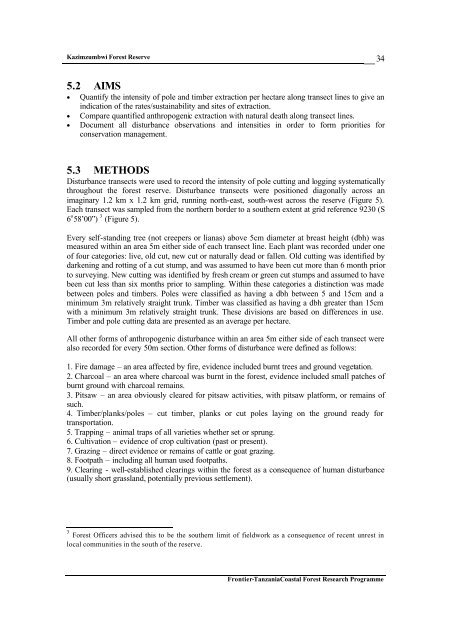Frontier Tanzania Environmental Research REPORT 110 ...
Frontier Tanzania Environmental Research REPORT 110 ...
Frontier Tanzania Environmental Research REPORT 110 ...
Create successful ePaper yourself
Turn your PDF publications into a flip-book with our unique Google optimized e-Paper software.
Kazimzumbwi Forest Reserve<br />
34<br />
5.2 AIMS<br />
• Quantify the intensity of pole and timber extraction per hectare along transect lines to give an<br />
indication of the rates/sustainability and sites of extraction.<br />
• Compare quantified anthropogenic extraction with natural death along transect lines.<br />
• Document all disturbance observations and intensities in order to form priorities for<br />
conservation management.<br />
5.3 METHODS<br />
Disturbance transects were used to record the intensity of pole cutting and logging systematically<br />
throughout the forest reserve. Disturbance transects were positioned diagonally across an<br />
imaginary 1.2 km x 1.2 km grid, running north-east, south-west across the reserve (Figure 5).<br />
Each transect was sampled from the northern border to a southern extent at grid reference 9230 (S<br />
6 o 58’00”) 3 (Figure 5).<br />
Every self-standing tree (not creepers or lianas) above 5cm diameter at breast height (dbh) was<br />
measured within an area 5m either side of each transect line. Each plant was recorded under one<br />
of four categories: live, old cut, new cut or naturally dead or fallen. Old cutting was identified by<br />
darkening and rotting of a cut stump, and was assumed to have been cut more than 6 month prior<br />
to surveying. New cutting was identified by fresh cream or green cut stumps and assumed to have<br />
been cut less than six months prior to sampling. Within these categories a distinction was made<br />
between poles and timbers. Poles were classified as having a dbh between 5 and 15cm and a<br />
minimum 3m relatively straight trunk. Timber was classified as having a dbh greater than 15cm<br />
with a minimum 3m relatively straight trunk. These divisions are based on differences in use.<br />
Timber and pole cutting data are presented as an average per hectare.<br />
All other forms of anthropogenic disturbance within an area 5m either side of each transect were<br />
also recorded for every 50m section. Other forms of disturbance were defined as follows:<br />
1. Fire damage – an area affected by fire, evidence included burnt trees and ground vegetation.<br />
2. Charcoal – an area where charcoal was burnt in the forest, evidence included small patches of<br />
burnt ground with charcoal remains.<br />
3. Pitsaw – an area obviously cleared for pitsaw activities, with pitsaw platform, or remains of<br />
such.<br />
4. Timber/planks/poles – cut timber, planks or cut poles laying on the ground ready for<br />
transportation.<br />
5. Trapping – animal traps of all varieties whether set or sprung.<br />
6. Cultivation – evidence of crop cultivation (past or present).<br />
7. Grazing – direct evidence or remains of cattle or goat grazing.<br />
8. Footpath – including all human used footpaths.<br />
9. Clearing - well-established clearings within the forest as a consequence of human disturbance<br />
(usually short grassland, potentially previous settlement).<br />
3<br />
Forest Officers advised this to be the southern limit of fieldwork as a consequence of recent unrest in<br />
local communities in the south of the reserve.<br />
<strong>Frontier</strong>-<strong>Tanzania</strong>Coastal Forest <strong>Research</strong> Programme

















